| Srl | Item |
| 1 |
ID:
118376
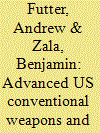

|
|
|
|
|
| Publication |
2013.
|
| Summary/Abstract |
The Obama administration has made a great effort to increase the role of advanced conventional weaponry in US national security thinking and practice, in part to help reinvigorate the global nuclear disarmament agenda by reducing the role played by nuclear weapons in the US defense posture. However, such a strategy is fundamentally flawed because increases in US conventional superiority will exacerbate US relative strength vis-à-vis other powers, and therefore make the prospect of a nuclear weapon-free world seem less attractive to Washington's current and potential nuclear rivals. Consequently, it is highly likely that the impact of efforts to increase US advanced conventional superiority through ballistic missile defense and a conventional "prompt global strike" program will ensure that the Obama administration is adopting a pathway to nuclear abolition on which it is the sole traveler for the foreseeable future.
|
|
|
|
|
|
|
|
|
|
|
|
|
|
|
|
| 2 |
ID:
092490
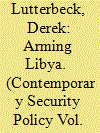

|
|
|
|
|
| Publication |
2009.
|
| Summary/Abstract |
Long isolated and shunned by many countries for its support of terrorist activites, Libya has over recent years re-emerged as an increasingly important player on the international scene.
|
|
|
|
|
|
|
|
|
|
|
|
|
|
|
|
| 3 |
ID:
062325
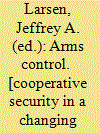

|
|
|
|
|
| Publication |
New Delhi, Viva Book Publisher, 2005.
|
| Description |
xviii, 413p.
|
| Standard Number |
8130900807
|
|
|
|
|
|
|
|
|
|
|
|
Copies: C:1/I:0,R:0,Q:0
Circulation
| Accession# | Call# | Current Location | Status | Policy | Location |
| 049653 | 327.174/LAR 049653 | Main | On Shelf | General | |
|
|
|
|
| 4 |
ID:
004300
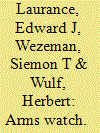

|
|
|
|
|
| Publication |
New York, Oxford University Press, 1993.
|
| Description |
xii,143p.Paperback
|
| Series |
SIPRI research report; 6
|
| Standard Number |
0198291779
|
|
|
|
|
|
|
|
|
|
|
|
Copies: C:2/I:0,R:0,Q:0
Circulation
| Accession# | Call# | Current Location | Status | Policy | Location |
| 035105 | 382.456234/LAU 035105 | Main | On Shelf | General | |
| 035346 | 382.456234/LAU 035346 | Main | On Shelf | General | |
|
|
|
|
| 5 |
ID:
094041


|
|
|
|
|
| Publication |
2010.
|
| Summary/Abstract |
During the third quarter of 2009, there was a spate of reports in the news media and on the Internet accusing Burma and North Korea of engaging in a range of activities that potentially threatened regional security. It was claimed that the Naypyidaw regime had developed a close relationship with Pyongyang that included North Korea's sale to Burma of conventional weapons, assistance in the development of Burma's defence infrastructure and arms industries, and even collaboration on a nuclear weapons program. Given the lack of hard evidence, however, these reports raised more questions than they answered. Burma's nuclear status remains unknown. Another puzzle is why no government or international organisation has yet made an official statement on this particular issue, despite all the publicity it has attracted. Should it be determined that Burma does indeed have a secret nuclear weapons program, then a key question would be whether the generals are likely to be any more receptive to international concerns than they have been in the past, on other issues.
|
|
|
|
|
|
|
|
|
|
|
|
|
|
|
|
| 6 |
ID:
115479
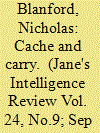

|
|
|
| 7 |
ID:
009461
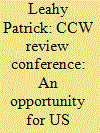

|
|
|
|
|
| Publication |
Sept 1995.
|
| Description |
20-24
|
|
|
|
|
|
|
|
|
|
|
|
|
|
|
|
| 8 |
ID:
046812
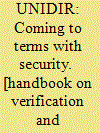

|
|
|
|
|
| Publication |
Geneva, UNIDIR, 2003.
|
| Description |
xi, 146p., xi, 159p.
|
| Standard Number |
9290451491
|
|
|
|
|
|
|
|
|
|
|
|
Copies: C:1/I:0,R:0,Q:0
Circulation
| Accession# | Call# | Current Location | Status | Policy | Location |
| 046845 | 355.03/UNI 046845 | Main | On Shelf | General | |
|
|
|
|
| 9 |
ID:
020617


|
|
|
|
|
| Publication |
2001.
|
| Description |
389--406
|
|
|
|
|
|
|
|
|
|
|
|
|
|
|
|
| 10 |
ID:
013842


|
|
|
|
|
| Publication |
Aug 1992.
|
| Description |
935-946
|
|
|
|
|
|
|
|
|
|
|
|
|
|
|
|
| 11 |
ID:
112452
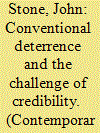

|
|
|
|
|
| Publication |
2012.
|
| Summary/Abstract |
The concept of 'credibility' is a central component of deterrence theory. In this article, credibility is used as a lens through which to examine the effectiveness of conventional force as a deterrent. An advantage that conventional force enjoys over its nuclear counterpart is that it can be used with much greater discrimination. Conventional threats can, therefore, be considered more politically credible than nuclear threats under all but the most extreme circumstances. Conversely, the relatively modest power of conventional weapons renders their effects 'interpretable' to a problematic degree by potential aggressors. Thus, such threats are less likely to be as technically credible as their nuclear equivalents. A range of communicative efforts may serve to reduce the scope for interpreting the effects possible to conventional weapons, although efforts of this kind risk being hampered by cultural obstacles. In consequence, success with conventional deterrence will turn on the ability to identify the specific technical and cultural conditions under which credible threats can readily be made.
|
|
|
|
|
|
|
|
|
|
|
|
|
|
|
|
| 12 |
ID:
150288


|
|
|
|
|
| Summary/Abstract |
When Senator Barack Obama (D-Ill.) was elected president in 2008, he had already demonstrated leadership in trying to curtail conventional arms proliferation.
|
|
|
|
|
|
|
|
|
|
|
|
|
|
|
|
| 13 |
ID:
083798


|
|
|
|
|
| Publication |
2008.
|
| Summary/Abstract |
The Pentagon has proposed developing conventionally armed, long-range weapons for a relatively new mission referred to as "prompt global strike". A weapon concept often considered for this mission is the modification of existing intercontinental ballistic missiles to deliver conventional munitions with precision accuracy. On the surface, this option appears straightforward and relatively inexpensive. However, Pentagon officials have, in the past, preferred other weapon concepts. Several developments over the past year combine to warrant a new look at this concept. This paper compares the conventional ICBM concept with alternative weapon concepts for the conventional prompt global strike mission.
|
|
|
|
|
|
|
|
|
|
|
|
|
|
|
|
| 14 |
ID:
129136
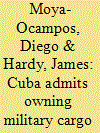

|
|
|
| 15 |
ID:
118119
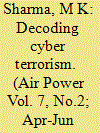

|
|
|
| 16 |
ID:
002407


|
|
|
|
|
| Publication |
London, International Institute for Strategic Studies,
|
| Description |
55p.
|
| Series |
Adelphi Paper; 193
|
| Standard Number |
0-86079-085-1
|
|
|
|
|
|
|
|
|
|
|
|
Copies: C:1/I:0,R:0,Q:0
Circulation
| Accession# | Call# | Current Location | Status | Policy | Location |
| 029874 | R 358.4/ALB 029874 | Main | On Shelf | General | |
|
|
|
|
| 17 |
ID:
127139


|
|
|
|
|
| Publication |
2014.
|
| Summary/Abstract |
Military planners believe that the 'blast and fragmentation' type conventional weapons cannot advance much further technologically.The next chapter in weapons technology development is expected to be realized from Directed Energy weapons (DEWs). It can be assumed that by 2035, DEWs consisting of laser, microwave and millimeter waves can reach current performance levels of the existing kinetic energy weapons(KEWs) and conventional weapons. While these will co-exist with KEWs,a non-DEW option would have a debilitating effect on the defence preparedness of any nation. Its numerous advantages has made DEWs a preferred project of choice for development by Russia, France, US and China. India too should consider the potential advantages of developing DEW technology. This article aims to highlight the importance of DEWs in the Indian context and urge thinkers and policymakers to make a roadmap for development of DEWs.
|
|
|
|
|
|
|
|
|
|
|
|
|
|
|
|
| 18 |
ID:
001102
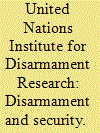

|
|
|
|
|
| Publication |
Geneva, United Nations, 1997.
|
| Description |
142p.
|
| Series |
UNIDIR Newsletter; no. 39
|
|
|
|
|
|
|
|
|
|
|
|
Copies: C:1/I:0,R:0,Q:0
Circulation
| Accession# | Call# | Current Location | Status | Policy | Location |
| 040606 | 327.174/DIS 040606 | Main | On Shelf | General | |
|
|
|
|
| 19 |
ID:
020549


|
|
|
|
|
| Publication |
Nov 2001.
|
| Description |
12-16
|
|
|
|
|
|
|
|
|
|
|
|
|
|
|
|
| 20 |
ID:
192492
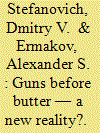

|
|
|
|
|
| Summary/Abstract |
Warfighting in Ukraine in 2022-2023 has become the first large-scale armed
conflict in Europe in the 21st century that directly involves Russia and
NATO. The scale of events, the geography of operations, the number of
weapons used and the personnel engaged require a reassessment of military
development and defense spending priorities in many countries around the
world. This article analyzes certain features of the current armed conflict
and the decisions already made by individual countries. The authors come
to the conclusion that given the scale of military buildup in Europe and
elsewhere it is advisable to think about new measures to reduce risks now
and establish effective arms control in the future.
|
|
|
|
|
|
|
|
|
|
|
|
|
|
|
|